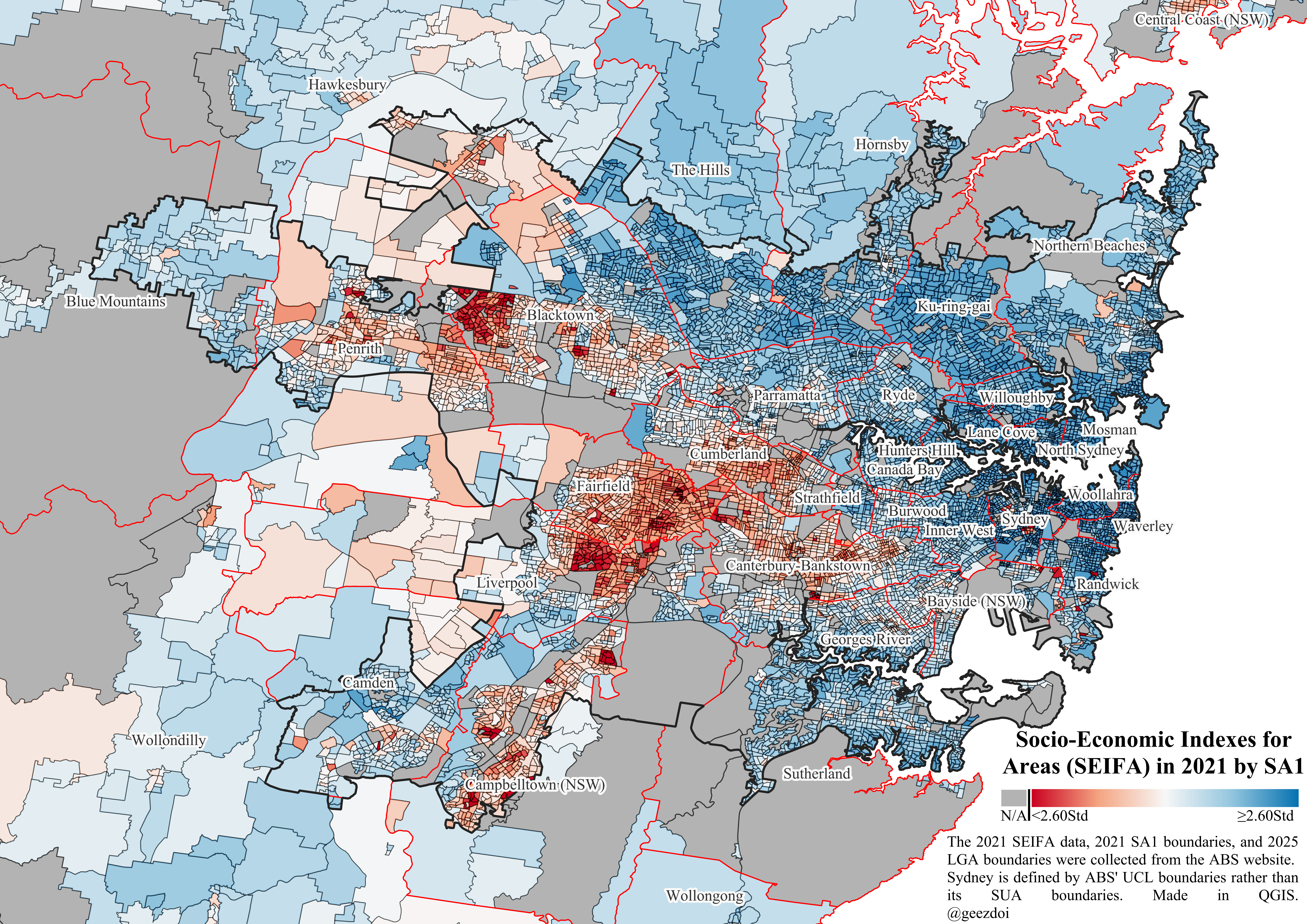Socio-Economic Advantage and Disadvantage Map of Sydney


Marcus Rodriguez
Historical Geography Expert
Marcus Rodriguez specializes in historical cartography and geographic data analysis. With a background in both history and geography, he brings unique...
Geographic Analysis
What This Map Shows
The "Map of Relative Socio-Economic Advantage and Disadvantage within Sydney" provides a visual representation of socio-economic disparities across various regions of Sydney. This map highlights areas of affluence alongside those grappling with socio-economic challenges. By using distinct color gradients, the map effectively communicates the relative advantage or disadvantage of different neighborhoods, offering insight into income levels, education, employment rates, and overall living conditions.
Deep Dive into Socio-Economic Factors
Socio-economic factors are crucial in understanding the dynamics of any city, and Sydney is no exception. The socio-economic landscape in Sydney is shaped by a variety of elements, including income distribution, housing affordability, education access, and employment opportunities. Interestingly, socio-economic status often reflects a complex interplay of these factors, which can significantly impact residents' quality of life.
For instance, areas marked as socio-economically advantaged, such as the affluent suburbs of the Eastern Suburbs like Bondi and Double Bay, are characterized by high-income earners, premium housing, and access to elite educational institutions. According to the 2021 Census, the median weekly household income in these areas can exceed AUD 2,000, illustrating the stark contrast with less advantaged regions.
Conversely, neighborhoods in the southwestern parts of Sydney, such as parts of Liverpool and Fairfield, often face challenges such as lower income levels, higher unemployment rates, and reduced access to quality education and healthcare. In these areas, the median weekly income can fall below AUD 1,200, indicating a pressing need for policies aimed at addressing these socio-economic disparities.
Moreover, these socio-economic factors are often tied to historical and demographic trends. For instance, areas with significant immigrant populations may experience different socio-economic challenges, including language barriers and limited access to services. Research shows that around 30% of Sydney's population is born overseas, significantly influencing socio-economic conditions across different suburbs.
Regional Analysis
When analyzing the map, it's evident that socio-economic advantage and disadvantage are not uniformly distributed across Sydney. For example, the inner-city areas such as Surry Hills and Newtown showcase a mix of affluence and diversity, attracting a younger demographic often involved in creative industries. The socio-economic advantage here is reflected in the vibrant cultural scene and an abundance of amenities, yet it also faces challenges related to rising living costs and gentrification.
In stark contrast, the outer suburbs, particularly in the west and southwest, reveal a different story. Suburbs like Mount Druitt and Blacktown are often highlighted as disadvantaged regions. Here, lower average household incomes and higher unemployment rates pose significant barriers to economic mobility. Interestingly, these areas are also home to a younger population, indicating potential for growth if coupled with the right educational and employment initiatives.
Furthermore, the map reveals how socio-economic status can impact access to public services. For instance, areas classified as disadvantaged often report fewer healthcare facilities and educational institutions, perpetuating cycles of disadvantage. In Australia, studies have shown that students from socio-economically disadvantaged backgrounds are less likely to complete high school or pursue higher education, further entrenching these disparities.
Significance and Impact
Understanding the socio-economic landscape of Sydney is vital for policymakers, urban planners, and community organizations. These insights can inform targeted interventions aimed at reducing inequality and improving living conditions for disadvantaged communities. Addressing these disparities is not only a moral imperative but also essential for fostering a more sustainable and equitable city.
Currently, trends indicate a growing awareness of these issues, with various initiatives aimed at improving educational access and employment opportunities in disadvantaged suburbs. Programs focusing on skills training and community development are being implemented to uplift these areas.
Looking ahead, the socio-economic landscape of Sydney is likely to evolve, especially as urban development continues and the impacts of climate change become more pronounced. Have you noticed how shifting demographics and economic pressures are reshaping neighborhoods across the city? The ongoing dialogue around these issues will be crucial in ensuring that Sydney remains a vibrant and inclusive metropolis for all its residents.
Visualization Details
- Published
- September 26, 2025
- Views
- 68
Comments
Loading comments...